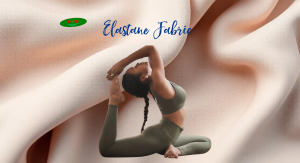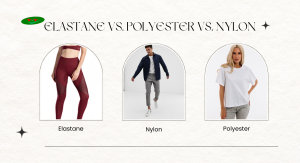Covered elastic yarn is a versatile material used in a wide array of textile applications. Its unique combination of elasticity, durability, and comfort makes it an essential component in various garments and products. As the fashion and textile industries continue to innovate, covered elastic yarn plays a pivotal role in enhancing the functionality and aesthetic appeal of clothing.
Introduction to Covered Elastic Yarn and Covered Spandex Yarn

In the fast-paced world of textiles, understanding the materials we work with is crucial. Covered elastic yarn and its counterpart, covered spandex yarn, are two important fibers that have revolutionized clothing design.
Definition of Covered Elastic Yarn
Covered elastic yarn refers to a type of yarn that has been coated or “covered” with another fiber, usually for added durability and versatility. The core of this yarn typically consists of elastic materials, providing the inherent stretch and recovery properties that make it desirable for various applications. The covering can vary from cotton to nylon or polyester, depending on the intended use of the yarn.
The main advantage of covered elastic yarn is its ability to provide stretch without losing shape. This flexibility allows for a comfortable fit while maintaining the garment’s original form, making it ideal for activewear, swimwear, and undergarments.
Definition of Covered Spandex Yarn
Covered spandex yarn works on similar principles but specifically uses spandex as the core fiber. Spandex is renowned for its exceptional elasticity, allowing it to stretch up to five times its length while still returning to its original size. The covered component of this yarn enhances its durability and texture, making it pleasant against the skin.
Covered spandex yarn is particularly popular in fashion-forward designs, where both function and style are essential. The blend of spandex with other fibers results in fabrics that are not only stretchy but also breathable and lightweight.
Importance of Covered Yarns in Textile Industry
Both covered elastic yarn and covered spandex yarn play a critical role in the textile industry. Their ability to combine comfort, durability, and stretchability has made them indispensable in modern garment manufacturing.
Moreover, as consumer demands grow for high-performance fabrics, the significance of these covered yarns continues to rise. They allow designers to experiment with innovative styles while ensuring their creations meet the practical needs of wearers. With the trend towards athleisure and functional wear, the market for covered yarns is likely to expand even further.
Properties and Characteristics
To fully appreciate the benefits of covered elastic and spandex yarns, it’s vital to explore their properties and characteristics. These features make them preferable choices for a variety of applications in the textile industry.
Elasticity and Durability
One of the standout characteristics of covered elastic yarn is its exceptional elasticity. This property allows garments to stretch comfortably during movement and then return to their original shape. Whether it’s a pair of leggings, a fitted shirt, or a supportive sports bra, the elasticity ensures that the fabric adapts to the body’s movements.
Durability is another significant attribute of these yarns. The covering protects the elastic core from wear and tear, enhancing the lifespan of the garment. Unlike traditional elastic bands that can fray or lose their stretch over time, covered yarn maintains its integrity, making it a reliable choice for everyday wear.
The combination of elasticity and durability means that clothing made from covered yarns can withstand rigorous activities like running or yoga without compromising on performance. This characteristic aligns perfectly with the growing trend towards active lifestyles.
Comfort and Fit
Comfort is paramount when it comes to clothing. Covered elastic and spandex yarns excel in this area due to their soft textures and ability to contour to various body shapes. Fabrics made from these yarns often have a second-skin feel, allowing for unrestricted movement.
Moreover, the snug fit provided by these yarns contributes to a flattering silhouette. They hug the body in all the right places, enhancing confidence in wearers. This aspect is particularly appealing in activewear and shapewear, where function meets fashion seamlessly.
Designers often incorporate covered yarns into their collections to ensure that their pieces are both aesthetically pleasing and comfortable. The versatility of these yarns allows for various styles, whether high-waisted leggings or fitted tops.
Breathability and Moisture Management
In the realm of activewear, breathability is crucial for optimal performance. Covered elastic and spandex yarns often feature advanced moisture-wicking technologies that draw sweat away from the body. This helps to maintain a comfortable temperature during physical activities, preventing overheating.
Additionally, the breathability of these yarns contributes to overall comfort. Garments made from covered yarns allow air to circulate freely, reducing the likelihood of irritation or discomfort. This characteristic is especially vital in warm climates or during intense workouts.
For those engaged in sports or outdoor activities, the moisture management capabilities of these fabrics mean they can focus on their performance rather than dealing with uncomfortable clothing. This synergy between comfort and functionality positions covered yarns as a leading choice for a wide array of applications.
Resistance to Wear and Tear
Garments endure a lot of stress throughout their lifespan. Covered elastic and spandex yarns demonstrate impressive resistance to wear and tear, making them suitable for items that experience frequent use and washing.
The protective covering around the elastic core helps prevent damage from friction, which is common in areas prone to chafing or stretching, such as the thighs or waistband. This feature ensures that clothing retains its shape and performance characteristics, even after multiple washes or strenuous activities.
In summary, the resistance to wear and tear exhibited by covered yarns not only prolongs the life of garments but also enhances the value proposition for consumers seeking durable apparel options.
Applications of Covered Elastic and Spandex Yarn
Given their numerous benefits, covered elastic and spandex yarns find extensive use across various sectors of the textile industry.
Activewear and Sports Apparel
In today’s fitness-conscious world, activewear has become a staple in many wardrobes. Covered elastic and spandex yarns are the backbone of this booming industry, enabling the creation of garments that marry style and functionality seamlessly.
From yoga pants to running shorts, these yarns allow for a range of motion, ensuring comfort during a wide array of exercises. The high-stretch quality offered by covered yarns helps athletes perform at their best without feeling constricted.
Moreover, the aesthetic appeal of activewear made from covered yarns cannot be overstated. Designers utilize vibrant colors, patterns, and textures, creating garments that inspire confidence both in and out of the gym. This stylish approach to functionality has led to the rise of athleisure, where workout clothes seamlessly transition to everyday wear.
Underwear and Hosiery
Underwear and hosiery are perhaps the most intimate applications of covered elastic and spandex yarns. Comfort is of utmost importance in these categories, and covered yarns deliver exactly that.
Underwear made from covered elastic yarn offers a soft touch against the skin while providing ample stretch for a secure yet comfortable fit. The absence of irritating seams or tags enhances the overall wearing experience, making these pieces ideal for daily wear.
Similarly, hosiery crafted from covered spandex yarn offers a flawless finish. The stretch properties create an elegant silhouette while ensuring that the tights or leggings remain in place without sagging or rolling down. This combination of comfort and aesthetics elevates the standard of everyday essentials.
Swimwear and Active Swimwear
Swimwear heavily relies on the properties of covered elastic and spandex yarns. The need for flexibility and support in swimsuits makes these yarns an excellent choice for designers.
Swimwear featuring covered yarns allows for ease of movement while remaining stylish. Many brands have embraced the use of these materials to craft high-performance swimsuits that cater to competitive swimmers and casual beachgoers alike.
Moreover, the moisture-resistant qualities of covered yarns contribute to the longevity of swimwear. Unlike traditional fabrics, covered yarns dry quickly and resist fading from prolonged exposure to chlorine or saltwater. This durability ensures that swimwear maintains its vibrant colors and shape, even after multiple outings.
Fashion and Designer Wear
In the realm of high fashion, covered elastic and spandex yarns are not just functional; they also serve as a canvas for creativity. Designers are increasingly incorporating these yarns into their collections to push the boundaries of traditional fashion.
The stretchiness of covered yarns allows for innovative cuts and silhouettes that were previously unattainable. From figure-hugging dresses to sculptural tops, these materials enable designers to experiment with form and fit in exciting ways.
Additionally, the incorporation of covered yarns into luxury fashion demonstrates their versatility. High-end brands have recognized the potential of these materials, producing glamorous yet comfortable pieces that cater to discerning consumers. The marriage of performance and style paves the way for a new era in designer wear.
Manufacturing Process
Understanding the manufacturing process of covered elastic and spandex yarns provides insight into the craftsmanship that goes into creating these remarkable materials.
Overview of Yarn Production
The journey of creating covered elastic and spandex yarn begins with selecting the appropriate fibers. The core typically consists of elastic or spandex, while the covering can be a variety of materials such as nylon, polyester, or cotton.
Once the fibers are chosen, they undergo a series of processes including spinning, twisting, and covering. During spinning, the fibers are drawn together to create a continuous strand, which is then twisted to add strength.
The covering process involves wrapping the outer fiber around the core, ensuring that the elastic stays protected while allowing it to retain its stretch. This intricate production chain results in high-quality covered yarns that can meet the diverse demands of the textile industry.
Techniques for Covering Yarn
There are several techniques employed in the covering of elastic and spandex yarns. One of the most common methods is known as “texturing,” where the covering fiber is crimped or textured to enhance the elasticity of the final product.
Another technique involves using specialized machinery called cover knitting machines. These machines can simultaneously knit and wrap the covering fiber around the core, resulting in a uniform texture and smooth finish. This method is particularly effective for high-volume production, ensuring consistency across large batches.
In recent years, advancements in technology have led to the development of new covering techniques that enhance the performance characteristics of the yarn. Innovations such as heat-setting and advanced dyeing processes have improved the durability and colorfastness of covered yarns, allowing for more vibrant and resilient fabrics.
Quality Control Measures in Production
Quality control is paramount in the production of covered elastic and spandex yarns. Manufacturers implement stringent testing procedures to ensure that each batch meets industry standards and customer expectations.
Common quality checks include measuring the elasticity, tensile strength, and abrasion resistance of the yarn. These tests help identify any defects that could affect the performance of the final garment.
Moreover, regular inspections throughout the manufacturing process guarantee that any issues are addressed promptly. This commitment to quality not only enhances the reputation of the manufacturer but also ensures that consumers receive reliable products that meet their needs.
Choosing the Right Type of Covered Yarn
When it comes to selecting the right type of covered yarn for a project, several factors must be considered.
Factors to Consider When Selecting Yarn
Choosing the appropriate covered yarn involves evaluating the intended application and desired characteristics of the garment. Factors such as elasticity, durability, and texture should guide the decision-making process.
Understanding the end-use of the fabric is crucial. For instance, activewear may require a blend with higher spandex content for increased stretch, while swimwear may benefit from moisture-resistant materials. Additionally, considering the climate and seasonality can influence the choice of covering fibers as well.
Aesthetics also play a role in yarn selection. The color, sheen, and texture of covered yarns can significantly affect the overall look of the finished garment. Designers often explore various combinations to achieve the desired visual impact.
Comparing Different Brands and Products
With numerous brands and products available in the market, it can be challenging to determine which covered yarn is the right fit for a specific project. Conducting thorough research and comparisons can yield invaluable insights.
Reading reviews and ratings from fellow designers can provide information about the performance and reliability of different brands. Attending trade shows and industry events can also offer opportunities to sample products and connect with manufacturers directly.
Ultimately, choosing the right brand involves balancing quality, price, and availability. Investing in reputable brands ensures that the final product will not only meet expectations but also stand the test of time.
Sustainable Options in Covered Yarns
As sustainability continues to be a pressing issue within the textile industry, exploring eco-friendly options in covered yarns is becoming increasingly important. Many manufacturers are now offering sustainable alternatives made from recycled or organic fibers.
These sustainable covered yarns maintain the same level of performance while minimizing environmental impact. The use of environmentally friendly dyes and production methods further enhances the appeal of these options.
Choosing sustainable covered yarns aligns with the values of conscious consumers who prioritize ethical fashion. Incorporating these materials into designs not only reflects a commitment to sustainability but also resonates with an audience that seeks to make responsible purchasing decisions.
Conclusion

Inspiration can be found in every corner of the textile industry, but few materials offer the versatility and innovation of covered elastic and spandex yarns. With properties that enhance comfort, durability, and style, these yarns have transformed how we think about garment construction.
From activewear to high fashion, the applications of covered yarns are as diverse as the consumers who embrace them. As the industry continues to evolve, the potential for creativity and sustainability within this realm only grows stronger.
By understanding the fundamentals of covered elastic and spandex yarns, designers, manufacturers, and consumers alike can appreciate the artistry behind each piece of clothing. In a world where performance and style coexist, covered yarns are truly paving the way for the future of fashion.
Address: Thanh Hoa Hamlet, Thanh Dien Commune, Chau Thanh District, Tay Ninh Province, Vietnam
Mobile/whatsap: (+84) 984.841.239
Mail: sale@tanithread.com
Website:https://tanithread.com/



